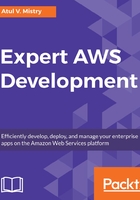
上QQ阅读APP看书,第一时间看更新
Brief introduction to AWS tools and SDKs
As we discussed in the introduction, AWS provides developer and command-line tools, toolkits, and SDKs to develop and manage AWS applications. Currently, AWS provides nine SDKs for different programming languages, six SDKs for IoT devices, and five SDKs for mobile devices. Let's take a brief look at this:
- Developer tools: Developer tools are used to store source code securely and version-control it. They also help with build automation and testing and deploying applications to AWS or on-premise. They include the AWS CodeCommit, AWS CodePipeline, AWS CodeBuild, and AWS CodeDeploy services. We will cover these in Chapter 4, CI/CD in AWS Part 1 – CodeCommit, CodeBuild, and Testing and Chapter 5, CI/CD in AWS Part 2 – CodeDeploy, CodePipeline, and CodeStar.
- SDKs: They provide APIs for programming languages, IoT, and mobile devices.
- IDE toolkits: Cloud tools which can integrate to your integrated development environment to speed up your AWS development.
- Command line: This is used to control AWS services from the command line and create scripts for automated service management.
- Serverless development: Serverless applications built on AWS Lambda can test and deploy using AWS Serverless Application Model (SAM) and SAM Local. We will cover Amazon Lambda in Chapter 10, Amazon Lambda – AWS Serverless Architecture.
AWS provides SDKs for the different languages and hardware devices to connect AWS IoT and mobile devices.
The following are the different kinds of SDK. In this chapter, we will cover two programming language SDKs, Java and Node.js:
